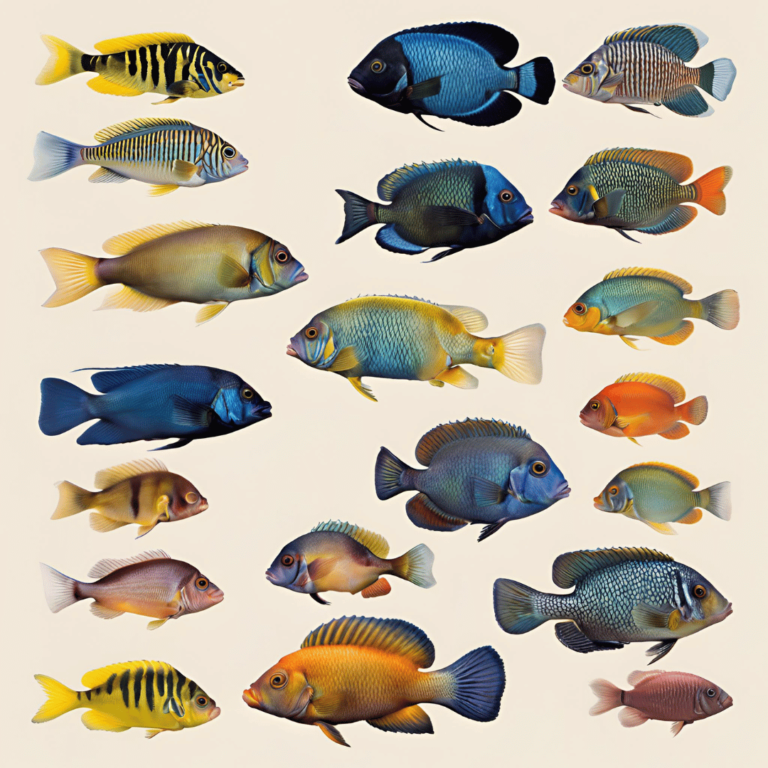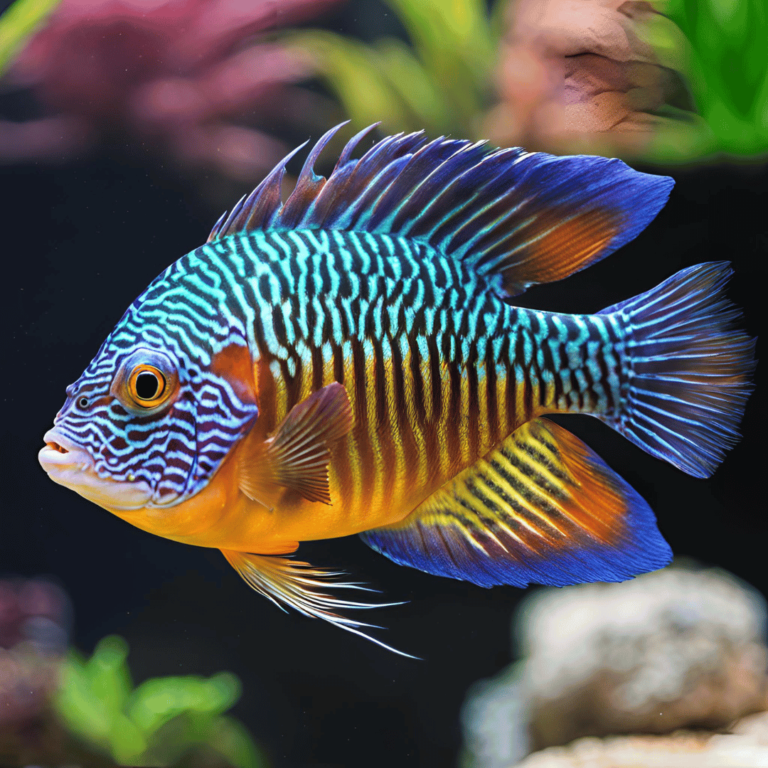Your trusted guide to cichlid care, tank setups, and quality products.

Peacock Cichlid Care: 7 Powerful Tips for Beginners
Starting your peacock cichlid journey? Our beginner's guide provides essential tips and advice for setting up a thriving tank, caring for your fish, and ensuring a rewarding experience.
Image credit: Canva
Are you mesmerized by the vibrant colors of peacock cichlids and thinking about adding these stunning fish to your aquarium? You’re not alone! Peacock cichlid care is essential for ensuring these fish thrive in your tank. Peacock cichlids are a favorite among aquarists for their brilliant hues and relatively easy care. Whether you’re new to fishkeeping or already have some experience, this peacock cichlid care guide will help you create a thriving environment for your peacock cichlids.
Let’s dive in.
At PeacockCichlid.com, we believe in transparency and honesty with our readers. Some of the links in this article are affiliate links, which means we may earn a small commission if you make a purchase through them—at no additional cost to you. These commissions help support our site, allowing us to continue providing expert advice, in-depth guides, and valuable content for Peacock Cichlid enthusiasts like you.
We only recommend products that we trust and believe will be beneficial for your aquarium. Thank you for your support!
Why Peacock Cichlids?
Peacock cichlids, originating from Lake Malawi in East Africa, are known for their dazzling colors and peaceful temperament compared to other cichlids. Their striking appearance, combined with their hardy nature, makes them an ideal choice for aquarists who want a vibrant yet manageable species.
But like all pets, they require a certain level of care to ensure they live healthy, happy lives. If you want your tank to be a shimmering display of colors, follow these seven essential tips for peacock cichlid care.
1. The Perfect Peacock Cichlid Care Tank Setup
One of the first steps in peacock cichlid care is creating the right home. They may be relatively peaceful, but they still need space and a well-organized tank to thrive.
Tank Size Matters
For beginners, it’s crucial to start with the right tank size. A minimum of 55 gallons is recommended for peacock cichlids, especially if you plan on having a small group. These fish are active swimmers, and overcrowding can lead to stress and aggression. Proper peacock cichlid care begins with giving them the room they need.
Aquascaping for Comfort
To mimic their natural environment, you’ll want to add rocks, caves, and hiding spots. These decorations not only look great but also provide shelter and help reduce territorial disputes. Avoid sharp objects that could harm your fish when they’re darting around. Aquascaping is a vital part of peacock cichlid care.
The Right Substrate
When it comes to substrate, sand or fine gravel is a great choice. Peacock cichlids love to dig, and a soft substrate allows them to exhibit their natural behaviors without damaging their scales or fins. Choosing the right substrate is key to successful peacock cichlid care.
2. Water Conditions for Peacock Cichlid Care
Peacock cichlids come from the clear, alkaline waters of Lake Malawi, so replicating those conditions is essential for their health. Water quality is one of the pillars of peacock cichlid care.
Water Parameters
- Temperature: 76-82°F (24-28°C) is ideal for keeping your peacock cichlids comfortable.
- pH: Aim for a pH between 7.8 and 8.6. These fish thrive in slightly alkaline water.
- Hardness: Moderate to hard water replicates their natural habitat.
Filtration and Aeration
Peacock cichlids produce a lot of waste, so a strong filtration system is a must. A canister or hang-on-back filter will help keep the water crystal clear. Make sure you also provide enough aeration, as they thrive in oxygen-rich water. Regular water changes—about 20-30% weekly—are vital for maintaining water quality, a cornerstone of peacock cichlid care.
3. Feeding Your Peacock Cichlids
One of the most exciting aspects of peacock cichlid care is feeding time! These fish are omnivores, which means they enjoy a variety of foods.
What to Feed
- High-quality cichlid pellets or flakes should form the base of their diet.
- Treat them to frozen or live foods such as brine shrimp or bloodworms once or twice a week to keep their diet varied.
- Adding blanched vegetables like zucchini or peas ensures they get enough fiber.
Feeding Schedule
Feed your peacock cichlids 2-3 times daily, giving them only what they can eat in a few minutes. Overfeeding can cause water quality issues and lead to health problems, so be mindful of portion sizes. Consistent feeding is essential in peacock cichlid care.
4. Understanding Peacock Cichlid Behavior
Peacock cichlids are generally peaceful, especially when compared to other African cichlids, but that doesn’t mean they don’t have a territorial side. Understanding behavior is a key part of peacock cichlid care.
Temperament
While they may stake out their own spaces within the tank, peacock cichlids are typically less aggressive than other cichlid species. However, during breeding, males can become territorial, so having plenty of hiding spots is crucial to prevent conflicts.
Tank Mates
Peacock cichlids are best kept with other African cichlids or species of similar size and temperament. Avoid pairing them with overly aggressive fish or species that are much smaller, as this could lead to stress or worse. Choosing compatible tank mates is an essential step in peacock cichlid care.
5. Breeding Peacock Cichlids
If you’re interested in breeding peacock cichlids, the good news is they’re mouthbrooders, which makes for a fascinating process.
Male vs. Female
Males are typically more colorful and larger, while females tend to have more subdued colors. If you provide the right conditions—clean water, the correct pH, and plenty of hiding spaces—you may witness breeding behavior in your tank. Breeding success is a rewarding aspect of peacock cichlid care.
Caring for Fry
Female peacock cichlids will hold the fertilized eggs in their mouths for protection. Once the fry are released, you can separate them into a nursery tank to ensure they grow safely without the risk of being eaten by adults. Proper care for fry is a continuation of excellent peacock cichlid care.
6. Health and Common Issues in Peacock Cichlid Care
Like all fish, peacock cichlids can face health challenges, but with the right care, you can minimize the risk.
Common Diseases
Peacock cichlids are susceptible to conditions like Malawi bloat and ich. The key to preventing these illnesses is maintaining optimal water quality, providing a balanced diet, and minimizing stress. If you notice any signs of illness, like loss of color, labored breathing, or lethargy, act quickly to address the issue.
Preventive Care
Regularly testing your water parameters, performing water changes, and observing your fish for unusual behavior are all part of good preventive care. Healthy peacock cichlids will be active, colorful, and curious. Preventive health is integral to peacock cichlid care.
7. Bonus Tips for Thriving Peacock Cichlid Care
- Add live plants like Java fern or Anubias for added oxygenation and aesthetics.
- Use LED lighting to enhance the vibrancy of their colors.
- Introduce peacock cichlids gradually to the tank to minimize stress.
Final Thoughts
Caring for peacock cichlids is a rewarding experience, especially when you see them thriving in a well-maintained tank. With their stunning colors, lively personalities, and manageable care requirements, these fish can transform your aquarium into a beautiful underwater display.
For beginners, the key is to start slow, do your research, and enjoy the process of building a harmonious tank environment. With the right setup, water conditions, diet, and care, your peacock cichlids will flourish. Remember, every step you take in peacock cichlid care contributes to the health and happiness of these beautiful fish.
Do you have friends who love peacock cichlids too? Share this guide with them! Spread the knowledge and help other aquarists create the perfect home for their own dazzling peacock cichlids. Happy fishkeeping!
Now that you’re equipped with these essential tips for beginner care, why not dive deeper into our wealth of aquarium expertise? For more in-depth strategies, be sure to explore our article Peacock Cichlid Tank Maintenance: 14 Proven Tips for Success to fine-tune your daily upkeep, and avoid common pitfalls with Top 10 Mistakes to Avoid When Keeping Peacock Cichlids. If you’re interested in fostering a more harmonious tank environment, our guide 7 Proven Tips to Reduce Peacock Cichlid Aggression in Tanks is a must-read.
At peacochcichlid.com, we’re dedicated to helping you create a thriving aquatic habitat—visit us again for more valuable insights and follow our social media channels to stay updated on the latest tips and trends in Peacock Cichlid care!
FAQ’s
What is the ideal tank size for peacock cichlids?
For proper peacock cichlid care, a minimum tank size of 55 gallons is recommended, especially for a small group. Larger tanks reduce stress and allow for natural behavior.
Can peacock cichlids live with other cichlids?
Yes, peacock cichlids can live with other African cichlids that have a similar size and temperament. Avoid housing them with overly aggressive or much smaller species.
What are the best water parameters for peacock cichlid care?
Peacock cichlids thrive in water temperatures between 76-82°F, a pH of 7.8-8.6, and moderate to hard water conditions.
How often should I feed my peacock cichlids?
Feed your peacock cichlids 2-3 times daily. Provide them with high-quality cichlid pellets, occasional live or frozen foods, and blanched vegetables.
Are peacock cichlids aggressive?
Peacock cichlids are less aggressive than other cichlid species. However, males can become territorial, especially during breeding, so providing plenty of hiding spots is essential.
What types of substrate are best for peacock cichlid care?
Sand or fine gravel is ideal, as peacock cichlids enjoy digging. A soft substrate allows them to exhibit natural behaviors without harming themselves.
How do I prevent diseases in my peacock cichlids?
To prevent diseases like Malawi bloat or ich, maintain optimal water quality, provide a balanced diet, and minimize stress. Regular water testing and changes are vital.
Can peacock cichlids be bred in a home aquarium?
Yes, peacock cichlids are mouthbrooders and can be bred in a home tank. Ensure the water quality is excellent, and provide hiding spaces for breeding pairs.
What is the lifespan of peacock cichlids?
With proper care, peacock cichlids can live 6-8 years. Providing them with a healthy environment and diet contributes to their longevity.
Can I keep plants in a peacock cichlid tank?
Yes, live plants like Java fern and Anubias can thrive in a peacock cichlid tank. These plants add oxygen and enhance the tank’s aesthetic while withstanding cichlid digging behavior.



